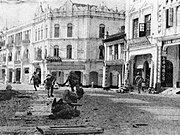
The outbreak of war in the Pacific in December 1941 found the British in Malaya completely unprepared. During the 1930s, anticipating the rising threat of Japanese naval power, they had built a great naval base at Singapore, but never anticipated an invasion of Malaya from the north. Because of the demands of the war in Europe, there was virtually no British air capacity in the Far East. The Japanese were thus able to attack from their bases in French Indo-China with impunity, and despite stubborn resistance from British, Australian and Indian forces, they overran Malaya in two months. Singapore, with no landward defences, no air cover and no water supply, was forced to surrender in February 1942, doing irreparable damage to British prestige. British North Borneo and Brunei were also occupied.
The Japanese had a racial policy just as the British did. They regarded the Malays as a colonial people liberated from British imperialist rule, and fostered a limited form of Malay nationalism, which gained them some degree of collaboration from the Malay civil service and intellectuals. (Most of the Sultans also collaborated with the Japanese, although they maintained later that they had done so unwillingly.) The occupiers regarded the Chinese, however, as enemy aliens, and treated them with great harshness: during the so-called sook ching (purification through suffering), up to 40,000 Chinese in Malaya and Singapore were killed. Chinese businesses were expropriated and Chinese schools closed. Not surprisingly the Chinese, led by the Malayan Communist Party (MCP), became the backbone of the Malayan People’s Anti-Japanese Army (MPAJA), which with British assistance became the most effective resistance force in the occupied Asian countries. But the Japanese also offended Malay nationalism by allowing their ally Thailand to re-annex the four northern states, Kedah, Perlis, Kelantan and Terengganu that had been surrendered to British in 1909. The loss of Malaya’s export markets soon produced mass unemployment which affected all races and made the Japanese increasingly unpopular.
The Malayans were thus on the whole glad to see the British back in 1945, but things could not remain as they were before the war. Britain was bankrupt and the new Labour government was keen to withdraw its forces from the East as soon as possible. Colonial self-rule and eventual independence were now British policy. The tide of colonial nationalism sweeping through Asia soon reached Malaya. But most Malays were more concerned with defending themselves against the Malayan Communist Party (MCP) which was mostly made up of Chinese, than with demanding independence from the British – indeed their immediate concern was that the British not leave and abandon the Malays to the armed Communists of the MPAJA, which was the largest armed force in the country. During the last year of the war there had been armed clashes between Chinese and Malays and many Malays were killed by the armed Chinese communists members of the MPAJA and the returning British found a country on the brink of civil war.
In 1946 the British announced plans for a Malayan Union, which would turn the Federated and Unfederated Malay States, plus Penang and Malacca (but not Singapore), into a unitary state, with a view to independence within a few years. There would be a common Malayan citizenship regardless of race. The Malays were horrified at this recognition that the Chinese and Indians were now to be a permanent and equal part of Malaya’s future, and vowed their opposition to the plan. The Sultans, who had initially supported it, backed down and placed themselves at the head of the resistance. In 1946 the United Malays National OrganisationDato Onn bin Jaafar, the Chief Minister of Johore. UMNO favoured independence for Malaya, but only if the new state was run exclusively by the Malays. Faced with implacable Malay opposition, the British dropped the plan. (UMNO) was founded by Malay nationalists led by
Meanwhile the Communists were moving towards open insurrection. The MPAJA had been disbanded in December 1945, and the MCP organised as a legal political party, but the MPAJA’s arms were carefully stored for future use. The MCP policy was for immediate independence with full equality for all races. This meant it recruited very few Malays. The Party’s strength was in the Chinese-dominated trade unions, particularly in Singapore, and in the Chinese schools, where the teachers, mostly born in China, saw the Communist Party of China as the leader of China’s national revival. In March 1947, reflecting the international Communist movement’s “turn to left” as the Cold War set in, the MCP leader Lai Tek was purged and replaced by the veteran MPAJA guerrilla leader Chin Peng, who turned the party increasingly to direct action. In July, following a string of assassinations of plantation managers, the colonial government struck back, declaring a State of Emergency, banning the MCP and arresting hundreds of its militants. The Party retreated to the jungle and formed the Malayan Peoples’ Liberation Army, with about 3,000 men under arms, almost all Chinese.
The Malayan Emergency involved six years of bitter fighting across the Malayan Peninsula. The British strategy, which proved ultimately successful, was to isolate the MCP from its support base by a combination of economic and political concessions to the Chinese and the resettlement of Chinese squatters into “New Villages” in “white areas” free of MCP influence. The effective mobilisation of the Malays against the MCP was also an important part the British strategy. From 1949 the MCP campaign lost momentum and the number of recruits fell sharply. Although the MCP succeeded in assassinating the British High Commissioner, Sir Henry Gurney, in October 1951, this turn to “terrorist” tactics alienated many moderate Chinese from the Party. The arrival of Lt-Gen Sir Gerald Templer as British commander in 1952 was the beginning of the end of the Emergency. Templer invented the techniques of counter-insurgency warfare in Malaya and applied them ruthlessly.


No comments:
Post a Comment